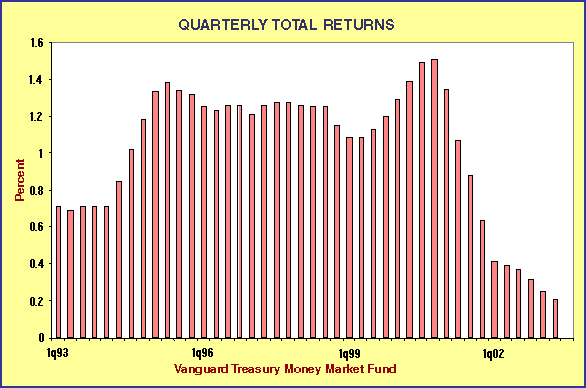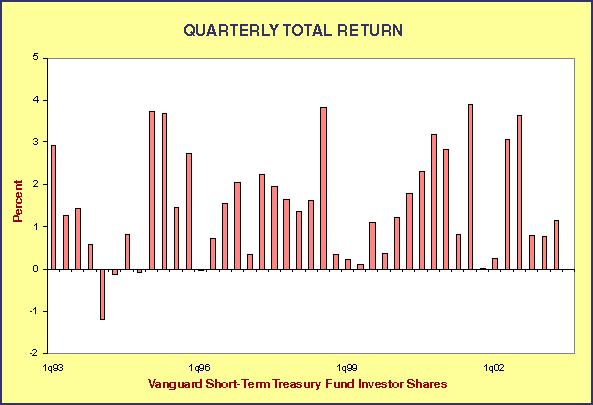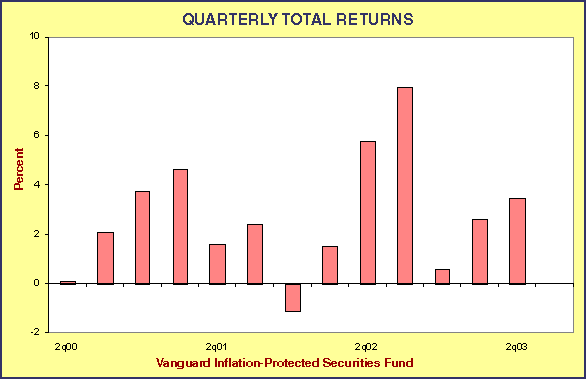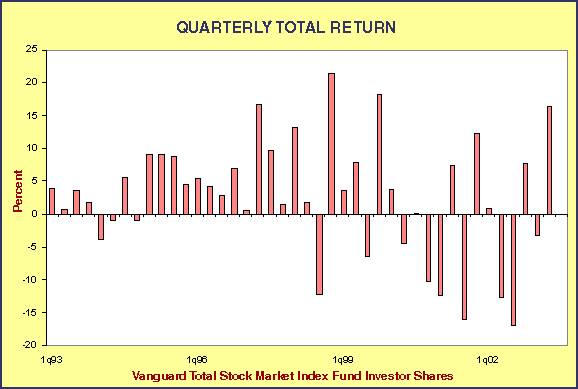
HOT TOPICS LIST
- Strategies
- Stocks
- Buy
- Investing
- Brokers
- Psychology
- Interviews
- Accumulate
- Sell
- Hold
- Spotlight
- Websites
- Candlestick Corner
- Gold & Metals
- Options Trading
LIST OF TOPICS
MUTUAL FUNDS
Take Charge Of Your Investing With Mutual Funds
10/08/03 03:19:27 PM PSTby Ram Vazirani
Investing isn't as hard as you think. Check out these mutual funds.
| Scandal upon scandal! Enron! Merrill Lynch! No one could blame you if you're sick and tired of investing and losing money due to circumstances beyond your control, but this is not the time for you to quit. You need to invest your savings now because Social Security alone will not be able to support you in your golden years. Once you get past all the crooks, slippery slopes, and dangerous paths, investing is not as hard as you think. If you want to manage your own money but don't have the time and don't know how to select a stock, bond, mutual fund, or even an advisor, you need to keep this in mind: Your investment program and results should reflect your background, needs, and risk tolerance level. You need to keep your expenses low. You are not a gambler. You just want to invest your savings intelligently.
GETTING STARTEDBefore you begin a long-term investing program, pay off your credit card loans, build an emergency fund, take care of your insurance needs, and consider buying a house if you haven't already. In addition, spend some time checking out annual total returns from stock, bond, and Treasury bill markets over the long term to gain some historical perspective (Figure 1).
Add up how much you need to fulfill all your financial requirements, and specify deadlines for yourself to attain those goals. Figure out how much you need to save on a regular basis to reach your targets. Whether you save weekly or yearly is not as important as making sure you never skip putting something aside. Some experts suggest that most of your bonuses and raises should go directly to your savings. Use your savings first to fund your eligible tax-deferred accounts before you divert them to taxable accounts. Accumulating wealth does not depend upon the size of your periodic investment, but how long you stay invested. As long as you invest regularly, you should begin investing as early as you can.
A DIVERSIFIED PORTFOLIOIf you invest your savings in just the following four Vanguard mutual funds, you will have a well-rounded portfolio:
Any of these four funds can be used in either retirement or taxable accounts, except that the tax laws lead some investors to use "I" bonds in their taxable accounts instead of VIPSX, which they use in their retirement accounts. Check how much each fund requires for opening an account and the minimum amount you need to add later. Let us look at each fund before discussing allocation of your savings to the funds. Remember not to extrapolate historical results of these funds into future expectations.
ASSET ALLOCATIONAfter you have outlined all your financial goals, you must determine how you want to distribute your savings in the four funds so you can reach your goals without losing sleep. How much of your total assets should be in the stock index fund depends upon your ability to tolerate loss and your time horizon. There is a two-step calculation that first computes the theoretical limit beyond which you should not invest in this fund, and then it figures the actual amount that you can invest. In its 77-year history, the Standard & Poor's 500 fell 43% in one year. If you can sleep well through such a sharp loss, you can put as much as 90% of your assets in the Vanguard Total Stock Market Index Fund Investor Shares (VTSMX). On the other hand, if you cannot tolerate a decline of any kind, keep at least 10% in this fund. For any other level of loss tolerance within this range, theoretical allocation to this fund should be proportional the ability to tolerate a 20% loss will restrict your investment in this fund to 50% of your assets. Next, incorporate your time horizon into this computation to calculate your actual allocation to this fund. Invest only up to 10% of your theoretical limit in this fund for each year that you plan to hold it. If you can tolerate a 30% loss and if you can invest for five years, you can actually put 35% of your total assets in this fund (your risk tolerance level of 30% loss limits your investment in this fund to 70% of your assets, and your five-year time horizon allows you to invest 50% that is, 10 times five of your theoretical limit of 70% or 35%). Incidentally, an employee within 15 years of retirement should not allocate more than 50% of assets to stocks. After you have determined the percentage of your assets that should be in the Vanguard Total Stock Market Index Fund Investor Shares, you can either divide equally the balance of your savings in the three remaining funds or allocate the balance to each of these three funds according to your timetable for fulfilling your different goals. Try to hold on to your asset allocations whenever you add periodic savings to your portfolio. When you receive a sudden windfall, avoid buying funds in a lump sum. Considering the volatile nature of the markets, it may be better to spread out investments in equal dollar amounts over 18 to 36 months.
REBALANCINGYou do not have to rebalance your total portfolio more than once a year. At that time, the portfolio should be restored to original percentage allocations unless there has been a significant change in your investment goals or risk tolerance levels. Avoid market timing or going in and out of the stock index fund; that is a game for profes sionals. Avoid frequent changes in your objectives, so you do not always end up buying at the top and selling at the bottom.
TAKE NOTEMutual funds are neither insured nor guaranteed. Although you can lose money in mutual funds, a well-diversified portfolio made up of the four mutual funds mentioned here can help you achieve your long-term goals. Diversification will reduce your risk exposure, although it will also lower your returns. Our approach is not based on any forecasts or market timing. We rely on regular saving, investing, and diversification. Each fund has a different objective, and the results of your total portfolio will be influenced by the funds where you have allocated most of your savings. Investors should not buy any fund until they have studied complete information about the fund and concluded that the fund is suitable for them. Although I have only mentioned the Vanguard funds, investors can use similar funds from other companies. Some Vanguard funds have more than one class of shares, with different minimums and expense ratios. Those listed here have the lowest minimums, and understandably highest expense ratios within the bunch, and yet they are competitive with other funds.
Ram S. Vazirani, a retired investment advisor in Pasadena, CA, can be reached at rvazirani@prodigy.net.
REFERENCEShttp://www.vanguard.comVanguard Treasury Money Market Fund (VMPXX) Vanguard Short-Term Treasury Fund Investor Shares (VFISX) Vanguard Inflation-Protected Securities Fund (VIPSX) Vanguard Total Stock Market Index Fund Investor Shares (VTSMX)
Current and past articles from Working Money, The Investors' Magazine, can be found at Working-Money.com.
|
| E-mail address: | rvazirani@prodigy.net |
PRINT THIS ARTICLE

|

Request Information From Our Sponsors
- StockCharts.com, Inc.
- Candle Patterns
- Candlestick Charting Explained
- Intermarket Technical Analysis
- John Murphy on Chart Analysis
- John Murphy's Chart Pattern Recognition
- John Murphy's Market Message
- MurphyExplainsMarketAnalysis-Intermarket Analysis
- MurphyExplainsMarketAnalysis-Visual Analysis
- StockCharts.com
- Technical Analysis of the Financial Markets
- The Visual Investor
- VectorVest, Inc.
- Executive Premier Workshop
- One-Day Options Course
- OptionsPro
- Retirement Income Workshop
- Sure-Fire Trading Systems (VectorVest, Inc.)
- Trading as a Business Workshop
- VectorVest 7 EOD
- VectorVest 7 RealTime/IntraDay
- VectorVest AutoTester
- VectorVest Educational Services
- VectorVest OnLine
- VectorVest Options Analyzer
- VectorVest ProGraphics v6.0
- VectorVest ProTrader 7
- VectorVest RealTime Derby Tool
- VectorVest Simulator
- VectorVest Variator
- VectorVest Watchdog





